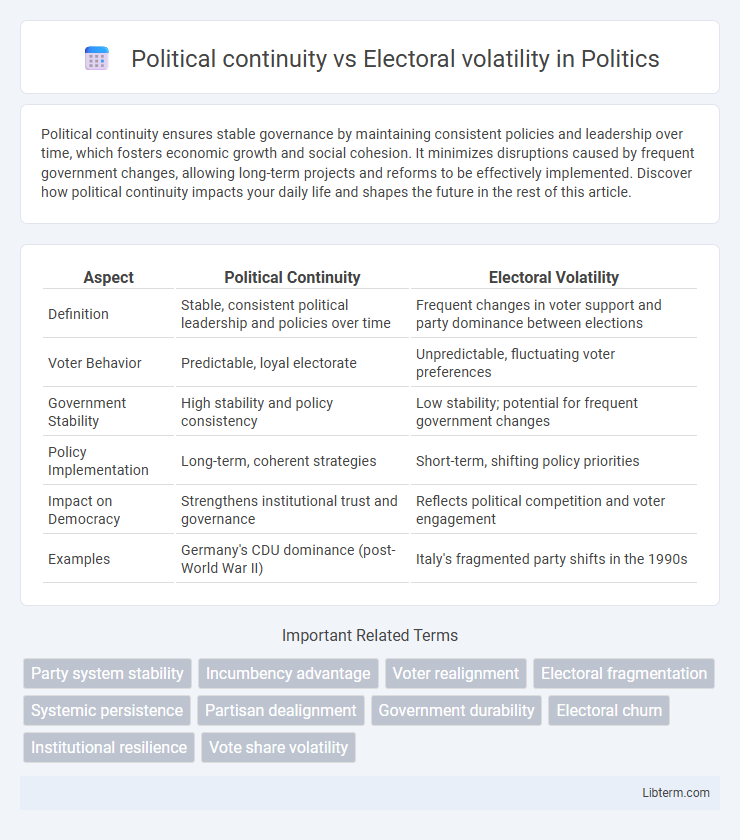Political continuity ensures stable governance by maintaining consistent policies and leadership over time, which fosters economic growth and social cohesion. It minimizes disruptions caused by frequent government changes, allowing long-term projects and reforms to be effectively implemented. Discover how political continuity impacts your daily life and shapes the future in the rest of this article.
Table of Comparison
| Aspect | Political Continuity | Electoral Volatility |
|---|---|---|
| Definition | Stable, consistent political leadership and policies over time | Frequent changes in voter support and party dominance between elections |
| Voter Behavior | Predictable, loyal electorate | Unpredictable, fluctuating voter preferences |
| Government Stability | High stability and policy consistency | Low stability; potential for frequent government changes |
| Policy Implementation | Long-term, coherent strategies | Short-term, shifting policy priorities |
| Impact on Democracy | Strengthens institutional trust and governance | Reflects political competition and voter engagement |
| Examples | Germany's CDU dominance (post-World War II) | Italy's fragmented party shifts in the 1990s |
Understanding Political Continuity
Political continuity reflects the stability of political parties, policies, and leadership over time, enabling consistent governance and policy implementation. It is often measured by factors such as voter loyalty, incumbency advantages, and the persistence of party systems within a country. Understanding political continuity provides insights into democratic consolidation, institutional trust, and the resilience of political structures amidst social and economic changes.
Defining Electoral Volatility
Electoral volatility measures the degree of change in voter support between elections, indicating shifts in political preferences and party strength. High electoral volatility reflects unstable political landscapes with frequent realignments, while low volatility suggests political continuity and stable voter loyalties. Understanding electoral volatility is crucial for analyzing democratic stability and predicting future electoral outcomes.
Historical Trends in Political Stability
Historical trends in political stability reveal that political continuity often correlates with sustained economic growth and effective governance structures. Electoral volatility, characterized by frequent shifts in voter preferences and party dominance, tends to disrupt policy consistency, leading to uncertain political environments. Analysis of established democracies shows that lower electoral volatility contributes to stable governmental institutions, while emerging democracies experience higher volatility linked to evolving political identities.
Causes of Electoral Volatility
Electoral volatility is often driven by factors such as economic instability, political scandals, and shifting voter alignments influenced by demographic changes and social movements. Fragmentation within political parties and the rise of new political actors contribute to unpredictable election outcomes, undermining political continuity. Media influence and changes in electoral systems can also exacerbate voter uncertainty, leading to fluctuating support patterns across election cycles.
Impacts on Governance and Policy
Political continuity ensures stable governance by allowing long-term policy planning and consistent implementation, which enhances institutional trust and investor confidence. In contrast, electoral volatility can lead to frequent changes in leadership and policy direction, creating uncertainty that hampers effective decision-making and disrupts public administration. High electoral volatility often challenges policy coherence, leading to fragmented reforms and weakened government performance.
Case Studies: Stable vs Volatile Democracies
Stable democracies such as Germany and Sweden display political continuity characterized by consistent party dominance, institutional trust, and predictable electoral patterns, which fosters policy stability and long-term governance. In contrast, volatile democracies like Brazil and Italy experience frequent party system changes, fragmented electorates, and erratic voter behavior, resulting in electoral volatility that challenges political stability and governance effectiveness. Comparative case studies reveal how institutional design, electoral rules, and socio-political contexts crucially influence the balance between political continuity and electoral volatility in democratic regimes.
Role of Political Parties
Political parties serve as stabilizing agents in political continuity by maintaining consistent policy platforms and fostering long-term voter loyalty, which mitigates electoral volatility. Strong party organization influences electoral outcomes by mobilizing supporters, shaping candidate selection, and providing clear ideological choices, thereby reducing frequent shifts in voter preferences. Conversely, weak or fragmented parties contribute to electoral volatility by failing to present coherent alternatives, leading to unpredictable election results and fluctuating political landscapes.
Voter Behavior and Sentiment
Voter behavior reflects political continuity when electorates consistently support established parties or incumbents, indicating stable political preferences and trust in governance. In contrast, electoral volatility arises from shifts in voter sentiment, often driven by dissatisfaction with current policies, emerging social issues, or changing demographic factors that prompt electorates to support alternative candidates or parties. Understanding these dynamics helps analyze how voter sentiment influences the stability or disruption of political systems during election cycles.
Strategies to Balance Stability and Change
Political continuity ensures governance stability by maintaining consistent policies and institutional frameworks, which fosters public trust and long-term economic growth. Electoral volatility introduces necessary change through voter realignment and new political actors, promoting adaptability and responsiveness to societal needs. Effective strategies to balance stability and change include implementing inclusive political reforms, strengthening democratic institutions, and encouraging civic engagement to manage transitions without undermining system legitimacy.
Future Outlook: Trends in Political Volatility
The future outlook on political volatility indicates increasing electoral unpredictability due to rising digital media influence and socio-economic polarization. Emerging trends highlight a shift toward fragmented party systems and fluctuating voter loyalties, challenging traditional political continuity. Data-driven analyses predict continued oscillation in voter behavior, emphasizing the need for adaptive strategies in electoral politics.
Political continuity Infographic

 libterm.com
libterm.com